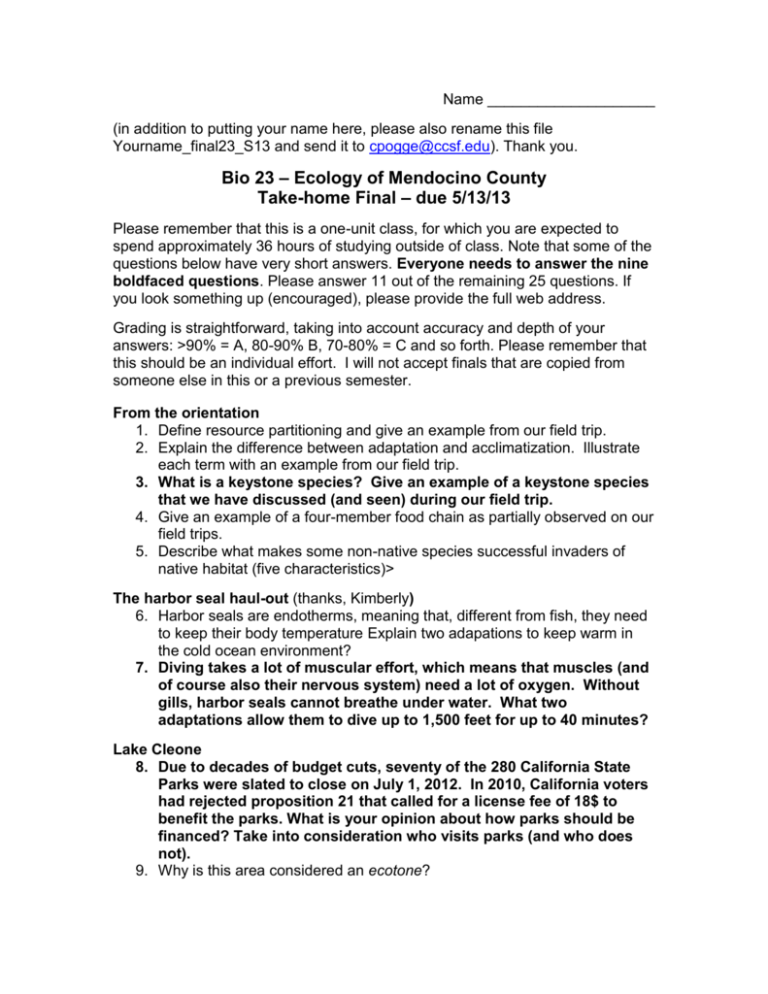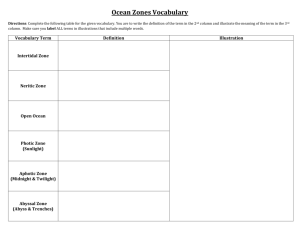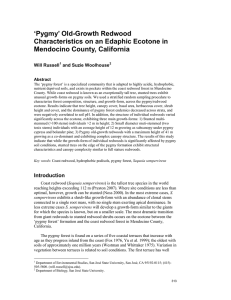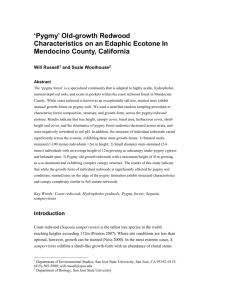Bio 23 – Ecology of Mendocino County Take-home Final
advertisement

Name ____________________ (in addition to putting your name here, please also rename this file Yourname_final23_S13 and send it to cpogge@ccsf.edu). Thank you. Bio 23 – Ecology of Mendocino County Take-home Final – due 5/13/13 Please remember that this is a one-unit class, for which you are expected to spend approximately 36 hours of studying outside of class. Note that some of the questions below have very short answers. Everyone needs to answer the nine boldfaced questions. Please answer 11 out of the remaining 25 questions. If you look something up (encouraged), please provide the full web address. Grading is straightforward, taking into account accuracy and depth of your answers: >90% = A, 80-90% B, 70-80% = C and so forth. Please remember that this should be an individual effort. I will not accept finals that are copied from someone else in this or a previous semester. From the orientation 1. Define resource partitioning and give an example from our field trip. 2. Explain the difference between adaptation and acclimatization. Illustrate each term with an example from our field trip. 3. What is a keystone species? Give an example of a keystone species that we have discussed (and seen) during our field trip. 4. Give an example of a four-member food chain as partially observed on our field trips. 5. Describe what makes some non-native species successful invaders of native habitat (five characteristics)> The harbor seal haul-out (thanks, Kimberly) 6. Harbor seals are endotherms, meaning that, different from fish, they need to keep their body temperature Explain two adapations to keep warm in the cold ocean environment? 7. Diving takes a lot of muscular effort, which means that muscles (and of course also their nervous system) need a lot of oxygen. Without gills, harbor seals cannot breathe under water. What two adaptations allow them to dive up to 1,500 feet for up to 40 minutes? Lake Cleone 8. Due to decades of budget cuts, seventy of the 280 California State Parks were slated to close on July 1, 2012. In 2010, California voters had rejected proposition 21 that called for a license fee of 18$ to benefit the parks. What is your opinion about how parks should be financed? Take into consideration who visits parks (and who does not). 9. Why is this area considered an ecotone? 10. Ecotones often exhibit much higher species diversity than other areas. This is due to the fact that they can accommodate species that need different ecosystems for different activities. Illustrate this fact with an example from Lake Cleone. Explain what habitats your species of choice uses. 11. Name two problems associated with stocking of rivers and lakes with trout and salmon, as was a widespread practice carried out by the Department of Fish and Game. Rocky intertidal 12. A) Why does increased atmospheric carbon dioxide lead to acidification of the oceans? B) Name two consequences of ocean acidification. 13. A) Why does increased atmospheric carbon dioxide lead to the warming of oceans? Name two consequence of ocean warming. 14. Why is coastal upwelling important for a) the region it occurs in and b) for the world at large? 15. Define biozonation and explain the factor most responsible for zonation in a rocky intertidal. 16. Describe three challenges of species living in the high intertidal zone and the adaptations to these challenges found in limpets (Teresa’s presentation). 17. Elizabeth entitled her talk “How bull kelp has shaped the world”. How has it shaped the world (three ideas). 18. You drew many organisms. Describe one of the organisms (except the limpet or bull kelp) and in which zone you found it. Look up two facts about its life history, paste those into this paper with their reference(s). Ten mile dunes 19. Three conditions need to come together to form dunes. One is a large supply of sand. Where did the sand that formed the dunes we visited come from? 20. What are the other two factors that need to be met for dunes to form? 21. So much to discuss, so little time! I never got to talk about the European beach grass. You might recall that I told you that the MacKerricher State Park Dune Rehabilitation Project includes removal of this grass. What problems does it pose (list your source)? 22. What three challenges do plants in the coastal strand community face and what adapations to these challenges are found in this community (thank you, Anastasia!)? 23. For the following five factors, hypothesize about their gradient from beach to upland forests. For each explain what you base your hypothesis on. Here is an example: I expect salt spray to diminish further away from the ocean, as the ocean is the source of that salt spray (that was easy!). Here are your five factors: Vegetation diversity, sand grain size, insect diversity, nitrogen, canopy height 24. What is the difference between a fen and a bog? And what is the big deal for biologists regarding the Inglenook fen? Van Damme Park 25. How do marine terraces form and why is the oldest marine terrace on top of the younger ones (thank you, Patty!) 26. Name three challenges that abalone face and three adaptations found in red abalone that help them survive in their habitat (thanks, Lisa!)? 27. How did logging in the Little river watershed contribute to the decimation of coho salmon (thanks, Ibara!). Here please describe conditions that coho need that were destroyed by logging. 28. I feel so bad about having called our newt a salamander (even though newts are salamanders)! So here is another question you all have to answer – what is the difference between newts and salamanders and did we see the rough-skinned newt or the redbellied newt (hopefully Ibara and Chris took pictures and here is a wonderful site that might help.) Pygmy Forest 29. What is the main reason for the stunted growth of Bolander pines in the pygmy forest (Thank you, Ellyn!)? 30. Many plants in the pygmy forest belong to the plant family Ericacea. List three of the plants from this family that we saw and describe how you can recognize members of this family. Montgomery Woods State Reserve 31. Marion (thank you!) talked about sudden oak death and pine pitch cancer. Name cause and symptoms for both. Which are the species most affected? 32. Adult coast redwood trees consume 200-500 gallons of water a day. Were do they get this much water in the Mendocino climate? 33. What adaptations allow coast redwood trees to withstand a) fire, b) windfall, c) competition from other tree species, and d) damage from insects. 34. Coast redwood create an inhospitable environment for seedlings both by the light interception of the canopy and the thick layer of branchlets. Explain their common way of reproducing.







